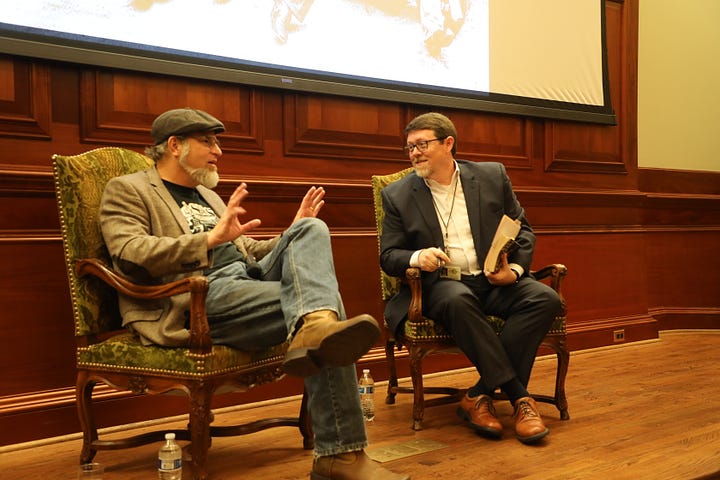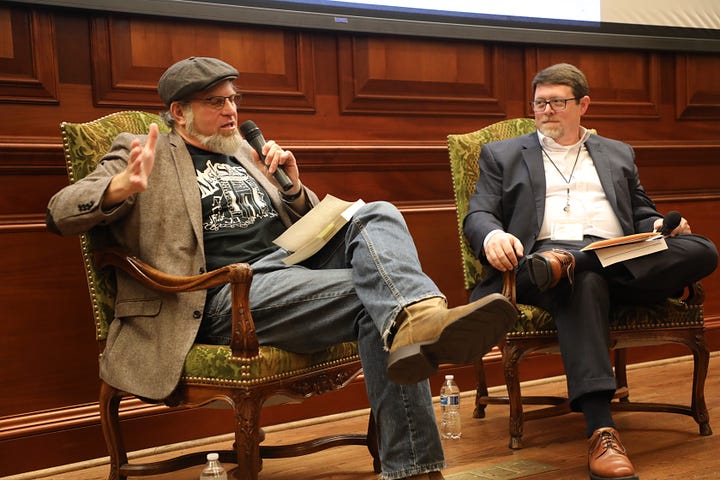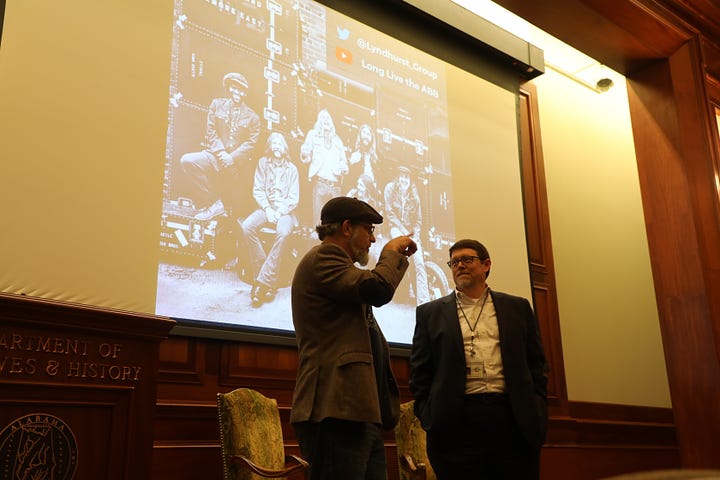I’ve spent a lot of time with myself lately. Not necessarily by myself, though that too, but with myself. Let me explain.
It began with a 600-mile, 9-hour, 2 day road trip to Alabama, where I had book talks at Auburn University’s Draughon Center for the Arts & Humanities and at the Alabama Department of Archives and History in Montgomery followed by a 3-day, 2-night trip to Denver, Colorado.




The book gigs, my first in Alabama, went REALLY well. Each interviewers—Tom Ritchie at Auburn and Steve Murray in Montgomery—gave me a lot of room to dig in to different aspects of Play All Night! (surely you’ve already purchased your copy).
Alabama features prominently in the ABB story. It was in Muscle Shoals Duane first made a name for himself at FAME Studios. His star turn on Wilson Pickett’s “Hey Jude” directly resulted in him securing a contract. Duane and Gregg played in Hour Glass from 1967-8 with two Alabamians, Johnny Sandlin and Paul Hornsby. ABB keyboardist Chuck Leavell (1972-6) is from Tuscaloosa. In March 1971, about a week after the At Fillmore East sessions, the group also was arrested for a pharmacopeia of drugs in Jackson. The group eventually plea bargained for lesser charges. As Gregg said in his memoir, “At one point, we just stopped playing Alabama.”
Keep and eye out for both of my Alabama talks on the Long Live the ABB Youtube channel.
On the way home from Montgomery, I had dinner in Birmingham with Cynthia Cardona, a pal going all the way back to graduate school at UCF in the 1990s. She’s also a fellow “good trouble” maker—one who *gets* the importance of history and museums. I arrived home both tired and inspired.
I had about 36 hours home before I flew to Denver to attend a memorial service for my friend and museum colleague Cinnamon Catlin-Legutko, who died this past January of cancer at 49-years old. (I’ve written about her here and dedicated this talk to her in February.) The event met under the banner of a national museum conference I last attended in 2019.1
Denver is also home to two longtime pals, Mark and Spencer, whom I got to spend some QUALITY time with each of them. Suffice it to say it was quite a homecoming.2
Though I was with people about half the time, I spent A LOT of time with myself. In my down time, I began listening back to my book talks as I edited and posted them on Youtube.
Youtube was not a part of the plan when I started recording my gigs, but about a month ago, I noticed a talk I gave last November started gaining traction. The audience for my lecture at Center for Popular Music at MTSU, my alma mater, included two of my dissertation advisors, a professor from whom I’d taken a class, and a graduate school classmate.
To be honest, I had left the talk thinking I bombed. YouTube told me different. People were watching the video, and they liked it enough that the algorithm caught it and started feeding it to others (32,000 views and counting!).
I suddenly had a new audience. And if I learned anything from my time working with and for history museums, you should pay attention to and nurture where folks are gathering for the cause.
In general, people are hungry for good history content. My expertise is the crossroads of music and history, specifically through the lens of the roots and legacy of the Allman Brothers Band. The good news is that I have plenty of content to upload as I’ve been recording all of my gigs since last fall. The bad news is that I had to listen to myself over and over and over again. This is what I meant when I said I spent a lot of time with myself lately.
Taking inspiration from the Allman Brothers Band’s improvisational aesthetic, each talk I’ve given for Play All Night is different. I ask the host to find an interested, curious person interview me. This allows me to be less formal, collaborate, and, frankly, have more fun.
I’ve also enjoyed listening back to each gig. I love revisiting how folks have received the book: their main takeaways and the things they choose to highlight. Reviewing my work also helps me stay focused as a presenter, because I can opine on Allman Brothers Band history a long, long time when given the opportunity.
I’ve saved the gigs I archived in a playlist, Play All Night on the Road. Other than the main video above, here are some other highlights:
Duane Allman and the ABB: Influence and Legacy in the Lone Star State with Jenn Landry, director of the Irving Archives and Museum
The Allman Brothers Band: Music as Conversation with Dr. Christopher Endrinal of Florida Gulf Coast University
Lessons from Duane Allman’s Journey to Fillmore East, the 2023 Byington Lecture on the Contemporary South
Listening to myself can be cringeworthy at times, but it’s worth it when I get to revisit a killer conversation with a friend about a subject I love: the Allman Brothers Band. I’m very grateful to be able to bring the conversation to you, as well.
Thanks for reading.
Here’s how one friend described his time at the conference. It mirrors my own experience, “The Magic of Serendipity.”
Denver is also where Candy and I first moved after college. We eloped at the Denver County Courthouse and saw Pearl Jam at Red Rocks that night. No shit.



